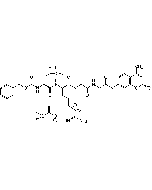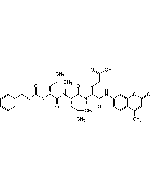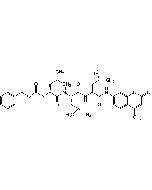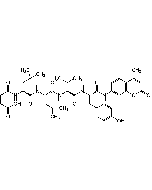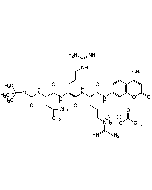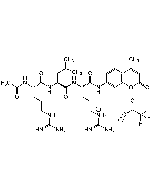Cookie Policy: This site uses cookies to improve your experience. You can find out more about our use of cookies in our Privacy Policy. By continuing to browse this site you agree to our use of cookies.
AdipoGen Life Sciences
Suc-Leu-Tyr-AMC
As low as
45
CHF
CHF 45.00
In stock
Only %1 left
AG-CP3-0017-M0055 mgCHF 45.00
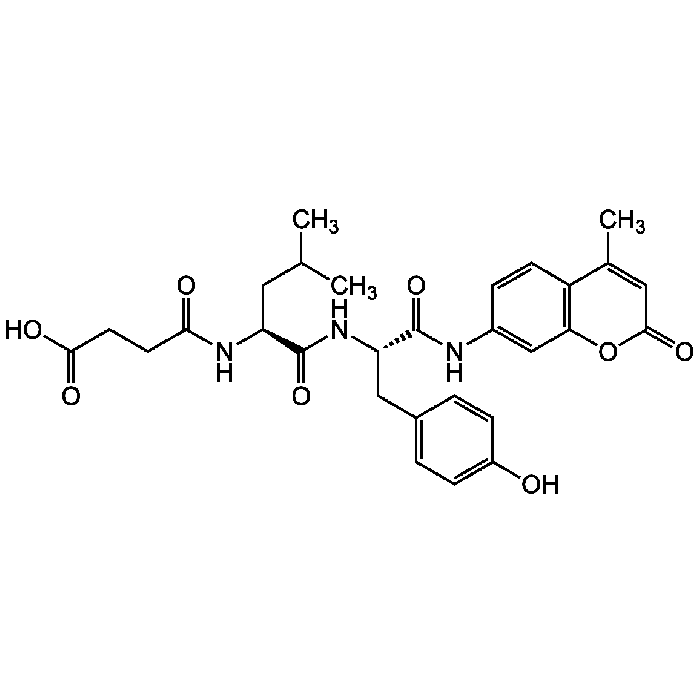
| Product Details | |
|---|---|
| Synonyms | Suc-LY-AMC; Proteasome Substrate; Calpain Substrate; Papain Substrate |
| Product Type | Chemical |
| Properties | |
| Formula |
C29H33N3O8 |
| MW | 551.6 |
| Sequence |
N-Succinyl-Leu-Tyr-7-amido-4-methylcoumarin |
| CAS | 94367-20-1 |
| Purity Chemicals | >98% (TLC) |
| Appearance | Solid lyophilized powder. |
| Solubility | Soluble in DMSO or methanol. |
| Other Product Data |
Use: Add from DMSO stock directly to in vitro or in vivo assays at desired concentration. Typical concentrations range from 10-100µM. |
| InChi Key | RIYLNECMTVNMSO-GOTSBHOMSA-N |
| Smiles | CC(C)C[C@H](NC(=O)CCC(O)=O)C(=O)N[C@@H](CC1=CC=C(O)C=C1)C(=O)NC1=CC2=C(C=C1)C(C)=CC(=O)O2 |
| Shipping and Handling | |
| Shipping | AMBIENT |
| Short Term Storage | +4°C |
| Long Term Storage | -20°C |
| Handling Advice |
Avoid freeze/thaw cycles. Protect from light. |
| Use/Stability | Stable for at least 1 year after receipt when stored at -20°C. |
| Documents | |
| MSDS |
 Download PDF Download PDF |
| Product Specification Sheet | |
| Datasheet |
 Download PDF Download PDF |
Description
- Fluorogenic substrate for measuring the chymotrypsin-like peptidase activity of the 20S proteasome.
- Fluorogenic substrate for calpain and papain.
- Peptide substrate for Ti protease from E.coli.
- Excitation: 360nm. Emission: 460nm.
- This substrate is useful for inhibitor screening and kinetic analysis.
Product References
- Comparative specificity and kinetic studies on porcine calpain I and calpain II with naturally occurring peptides and synthetic fluorogenic substrates: T. Sasaki, et al.; J. Biol. Chem. 259, 12489 (1984)
- Na+, K+-specific inhibition of protein and peptide hydrolyses by proteasomes from human hepatoma tissues: J.H. Seol, et al.; FEBS Lett. 247, 197 (1989)
- Protease Ti from Escherichia coli requires ATP hydrolysis for protein breakdown but not for hydrolysis of small peptides: K.M. Woo, et al.; J. Biol. Chem. 264, 2088 (1989)
- Ube2l3 gene expression is modulated by activation of the aryl hydrocarbon receptor: implications for p53 ubiquitination: O.D. Reyes-Hernandez, et al.; Biochem. Pharmacol. 80, 932 (2010)






